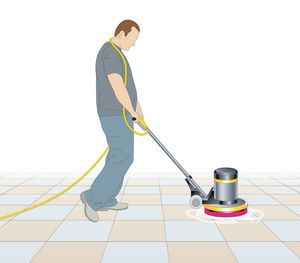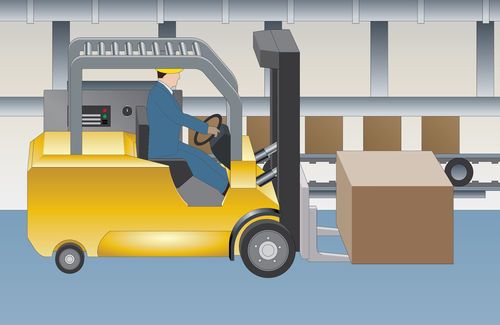
Cleaning and Maintaining an ESD Floor
[11 min read]

Overall procedures for maintaining ESD floors are similar to the care for regular floors. As with any flooring surface, different types of floors require different maintenance procedures. Depending upon how the floor is cleaned and maintained and what type of floor-care products are used, maintenance procedures may impact the floor’s performance.
To maintain their electrical performance, ESD floors must be cleaned regularly. A layer of dirt on an ESD floor could act as an insulator, preventing static from dissipating properly to ground.
Overall procedures for maintaining ESD floors are similar to the care for regular floors. As with any flooring surface, different types of floors require different maintenance procedures. Depending upon how the floor is cleaned and maintained and what type of floor-care products are used, maintenance procedures may impact the floor’s performance.
ESD Flooring Performance Considerations
ESD Vinyl
ESD vinyl products, while an efficient, cost-effective, durable static-control option, often require periodic buffing or waxing to maintain electrical performance. In fact, some vinyl tiles, e.g. SDT, are not warranted unless the customer regularly reapplies multiple coats of special antistatic floor polish.

ESD Carpet and Rubber
Carpet and rubber provide excellent long-term static protection and require only simple routine maintenance—vacuuming and steam cleaning for carpet. For rubber, wash the floor with a wet mop. Unless maintenance is completely neglected, performance won’t suffer.


ESD Epoxy
Epoxy is a strong, durable surface, ideal for areas requiring the use of forklifts or other heavy equipment. While easy to clean—requires regular washing—some ESD epoxy does not inhibit static generation. Continuous rolling of chair casters abrades epoxy and the original glossy appearance cannot be recaptured by buffing.
When Choosing an ESD Floor, Factor Maintenance and Repair into Total Cost of Ownership
The initial material and installation costs are only part of the total cost of owning a static-control floor. Every floor, whether standard or ESD, requires some kind of maintenance and repair. Over five years, these maintenance and repair costs can be significant. Calculated over the long-run, a less expensive floor may actually cost a lot more than a pricier option.
ESD Vinyl
Vinyl floors are the most difficult and costliest to maintain. Vinyl is durable and, in most cases, requires minimal repair; however, maintenance could be pricey. All vinyl floors require some form of regular buffing.
Beware of any claims that describe vinyl floors as having special factory-applied polyurethane (PU) coatings that never need to be waxed. PU coatings are static generators. A floor coated with PU might exhibit acceptable electrical ohms resistance properties but lab tests confirm that it will not meet the walking body voltage requirements of ANSI/ESD S97.2 in S20.20.
Beware of high-shine factory coatings on vinyl floors. These shiny surfaces are merely the result of a factory polish that will not last more than a few months. 
Bend and fold vinyl tiles as part of any due diligence evaluation of physical properties. Some vinyl floors are soft and become easily fragmented from stress loads. Broken tiles are unsightly, potential safety hazards, and, depending upon the extent of the damage, can create traffic interruptions during repair.
Vinyl floors are the most difficult and costliest to maintain. Vinyl is durable and, in most cases, requires minimal repair; however, maintenance could be pricey. All vinyl floors require some form of regular buffing.
Beware of any claims that describe vinyl floors as having special factory-applied polyurethane (PU) coatings that never need to be waxed. PU coatings are static generators. A floor coated with PU might exhibit acceptable electrical ohms resistance properties but lab tests confirm that it will not meet the walking body voltage requirements of ANSI/ESD S97.2 in S20.20.
Beware of high-shine factory coatings on vinyl floors. These shiny surfaces are merely the result of a factory polish that will not last more than a few months. 
Bend and fold vinyl tiles as part of any due diligence evaluation of physical properties. Some vinyl floors are soft and become easily fragmented from stress loads. Broken tiles are unsightly, potential safety hazards, and, depending upon the extent of the damage, can create traffic interruptions during repair.
ESD Epoxy
Epoxy floors need regular washing and gouges are extremely difficult to repair. Epoxy is notoriously hard to repair, and repairs can be particularly disruptive in occupied spaces, due to the two to three-day process of installation and drying. Some epoxies are also sensitive to ultraviolet exposure, causing the color to soften and fade in well-lit areas, making an installed epoxy floor difficult, if not impossible, to match.
ESD Carpet Tile
Carpet tile requires periodic vacuuming and yearly wet or dry extraction. In clean environments, such as 9-1-1 dispatch centers, critical call and data centers and server room applications, carpet tile maintenance is extremely low.
When evaluating carpet, pay close attention to the carpet fiber modification ratio. This ratio—an industry standard metric—helps prospective buyers determine the dirt retention and subsequent wear properties of a carpet, thus estimate how well the carpet will stand up to abuse and how long it will last. The lower the number, the rounder the fibers, the better the carpet will perform. A carpet with a modification ratio below 2.5 will perform well in areas with heavy to severe traffic.
While regular maintenance is cheap and easy, all carpet is vulnerable to chemical and solder spills. In manufacturing environments with messy operations or where there are likely to be solder or chemical spills, surfaces like vinyl, epoxy, or rubber are better options.
ESD Rubber
Rubber is the easiest and least expensive material to maintain, with the lowest total cost of ownership. Rubber is extremely durable and requires minimal maintenance. Unlike vinyl, rubber is not porous, so it will not capture dirt—but the floor still needs occasional scrubbing with a single disc machine or it will become dull.
Conductive Adhesives

Adhesives impact the cost of repair. Certain conductive adhesives dry quickly, while others take 24 to 72 hours to fully cure. Curing times can impact repairs considerably and, when downtime is factored in, drive up repair costs considerably.
✓ visual selector guide;
✓ walking body voltage/low static generation;
✓ resistance requirements and testing;
✓ ESD flooring comparison;
✓ industry standards & test methods;
✓ key ESD terms
Avoiding Problems Down the Road
To avoid unexpected problems down the road, think long-term and ask questions:
- What type of maintenance will the floor require?
- How disruptive will maintenance be? Some environments—mission critical spaces, for instance—operate 24/7 and cannot be shut down for routine maintenance.
- Will there be future construction? Can repairs or expansion installations be performed without interrupting ongoing work in occupied spaces?
- What are the environmental considerations? Will the floor be installed in an easily contaminated or high-traffic space, requiring more frequent or rigorous maintenance procedures?
- What type of maintenance will the floor require?
- How disruptive will maintenance be? Some environments—mission critical spaces, for instance—operate 24/7 and cannot be shut down for routine maintenance.
- Will there be future construction? Can repairs or expansion installations be performed without interrupting ongoing work in occupied spaces?
- What are the environmental considerations? Will the floor be installed in an easily contaminated or high-traffic space, requiring more frequent or rigorous maintenance procedures?
Buyers should also consider whether or not they’re prepared to monitor their maintenance team to ensure procedures are followed or foot the additional cost of maintaining the floor.
The way the floor is maintained directly impacts its lifecycle and appearance, as well as its ability to eliminate static electricity. Before purchasing a static-control floor, evaluate the material’s durability and long-term electrical performance—and be sure you understand exactly what maintenance people will encounter. Results are usually best when the people who will occupy and maintain the space are involved in the final flooring selection.
Get in Touch
The form below will help us better understand your needs and get you as quickly as possible to the right person. We look forward to helping you solve your static problem!
You can expect a response within 24 hours. For faster service, please give us a call: 617-923-2000
"*" indicates required fields
Visit our privacy policy to find out how we process data.
Learning Center Articles
- ESD Basics
- Installation & Maintenance
- Selecting & Specifying an ESD Floor
- Technical Information
- 7 Common Mistakes Selecting an ESD floor
- A Guide to ESD Flooring Selection
- Avoid Costly Failures: What You Need to Know When Specifying ESD Flooring
- Choosing ESD Flooring for:
- ESD Footwear: What Is It and When Is It Necessary?
- ESD Footwear for Electronics Manufacturing and Handling Applications
- Facility Managers’ Guide to Selecting ESD Flooring
- The Need for Due Diligence in Specifying Static-Free Flooring
- Standard of Care for Specifying Floors in Mission-Critical Spaces
- Understanding the Hidden Costs of ESD Flooring

StaticWorx high-performance static-control floors protect electronic components, explosives, and high-speed computers from damage caused by static electricity. ESD flooring is part of a system. Choices should always be based on objective, researched evidence. When you partner with us, we look at all possible items that may need to integrate with the floor, and, focusing on your goals and objectives, help you find the right floor for your application.











